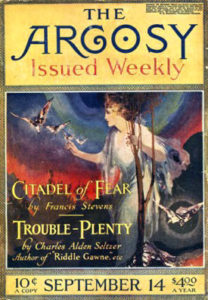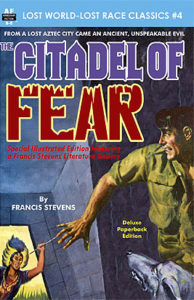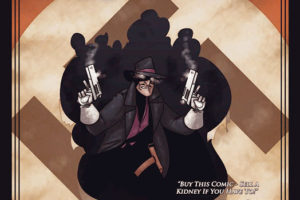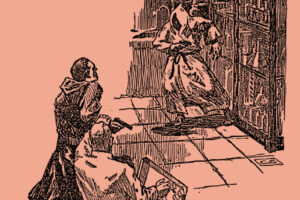 An interesting book I picked up recently was Francis Stevens’ The Citadel of Fear. Reprinted by Armchair Fiction as part of their Lost World-Lost Race series, this novel was originally serialized in The Argosy in 1918.
An interesting book I picked up recently was Francis Stevens’ The Citadel of Fear. Reprinted by Armchair Fiction as part of their Lost World-Lost Race series, this novel was originally serialized in The Argosy in 1918.
This particular edition had a short select of artwork from her other works (covers of their appearances in pulp magazines), as well as the wrap-around artwork for the Paperback Library reprint of Citadel. It also had a short bio of Stevens and it was interesting.
Francis Stevens was really Gertrude Barrows Bennett (1884–1948), an early author of fantasy and science fiction that some call the “woman who invented dark fantasy.” She actually dropped out of school after the eighth grade and later became a stenographer. Her first published work of fiction was a short story “The Curious Experience of Thomas Dunbar,” published in The Argosy in 1904. She later married and had a daughter, but her explorer husband died on an expedition. During World War I, her father died, and Gertrude had to help support her invalid mother.
To make more money, she turned to fiction writing, and between 1917 and 1923, she wrote various short stories and longer works that appeared in several pulp magazines at the time. Several are considered excellent to this day, which is pretty high praise for someone who didn’t even finish high school. Her first work was “Nightmare,” which told of an island where evolution went in a different direction, similar to Edgar Rice Burrough‘s “The Land That Time Forgot” that appeared a year later. Bison Books has a collection of all of her short fiction in a collection titled The Nightmare and Other Tales of Dark Fantasy.
 A year after Citadel, she put out “The Heads of Cerebus” in The Thrill Book. This novel (still available from Dover) is a dystopia where a trio of people are transported to the totalitarian world of Philadelphia in 2118 AD. Her best work is considered “Claimed” (Argosy, 1920), which has a strange box that summons an ancient and powerful god to modern New Jersey. This looks to be in print. She has a couple of other novels that have never been reprinted. Sadly, it seems that after her mother passed, she stopped writing any more fiction after 1923. I think had she continued she would be better known.
A year after Citadel, she put out “The Heads of Cerebus” in The Thrill Book. This novel (still available from Dover) is a dystopia where a trio of people are transported to the totalitarian world of Philadelphia in 2118 AD. Her best work is considered “Claimed” (Argosy, 1920), which has a strange box that summons an ancient and powerful god to modern New Jersey. This looks to be in print. She has a couple of other novels that have never been reprinted. Sadly, it seems that after her mother passed, she stopped writing any more fiction after 1923. I think had she continued she would be better known.
In The Citadel of Fear, two prospectors, Kennedy and Colin “Boots” O’Hara, are in Mexico looking for gold. After surviving a desert trek they come upon a hacienda and plantation deep in the jungle in a place that as far as they know is uninhabited. In doing so they find a deeper mystery of a lost race of white-skinned Aztecs tied to Quetzalcoatl! The people inhabit a hidden underground city of Tlapallam. But things go badly, and O’Hara is dumped in the desert to try to survive and Kennedy is made a prisoner. When O’Hara gets back to civilization, he’s not even certain the people and city he found were real or a dream.
Fifteen years later, he is visiting his sister after a recent expedition to the site. There he found the ruins of a hacienda and no sign of any hidden city, making him less certain it was real. But when his sister is alone at her house while O’Hara and her husband are in the city, and is attacked by some unknown creature, he isn’t too certain.
It seems the evil that was secured in Tlapallam is out, and Kennedy may be the one behind it! Colin must work to put an end to it to save the world. And he may get some help from an unexpected source.
I found this story to be pretty excellent and very readable for the modern audience. Stevens’ explanation for the horror is a mix of science and religion and is very imaginative. Again, for someone to write this who didn’t finish high school, I was pretty impressed. Clearly she was well read to have done so well. I recommend people check it out and Stevens’ other works. I hope to get a few of them myself and review them here.




So Gertrude Bennett used a male pen name, eh? No surprise-English novelist Mary Ann Evans wrote “Silas Marner”, “Middlemarch” and other works as “George Eliot”!
Nope, not surprising for the times. Some went with initials (ex: J.K. Rowling).
What is interesting is she had another pen name in mind (also male), but her first publisher went with “Francis Stevens”. That seemed to work, so she stuck with that.
Kind of sad she didn’t continue writing.
Let’s not forget that years later, a certain Andre Norton wrote as Andrew North, and is often referenced as being forced in her time to write under a male nom de plume. She “clearly” was predated by other female writers, but they unjustly receive less attention than she has!
Definitely something I would like to read also.